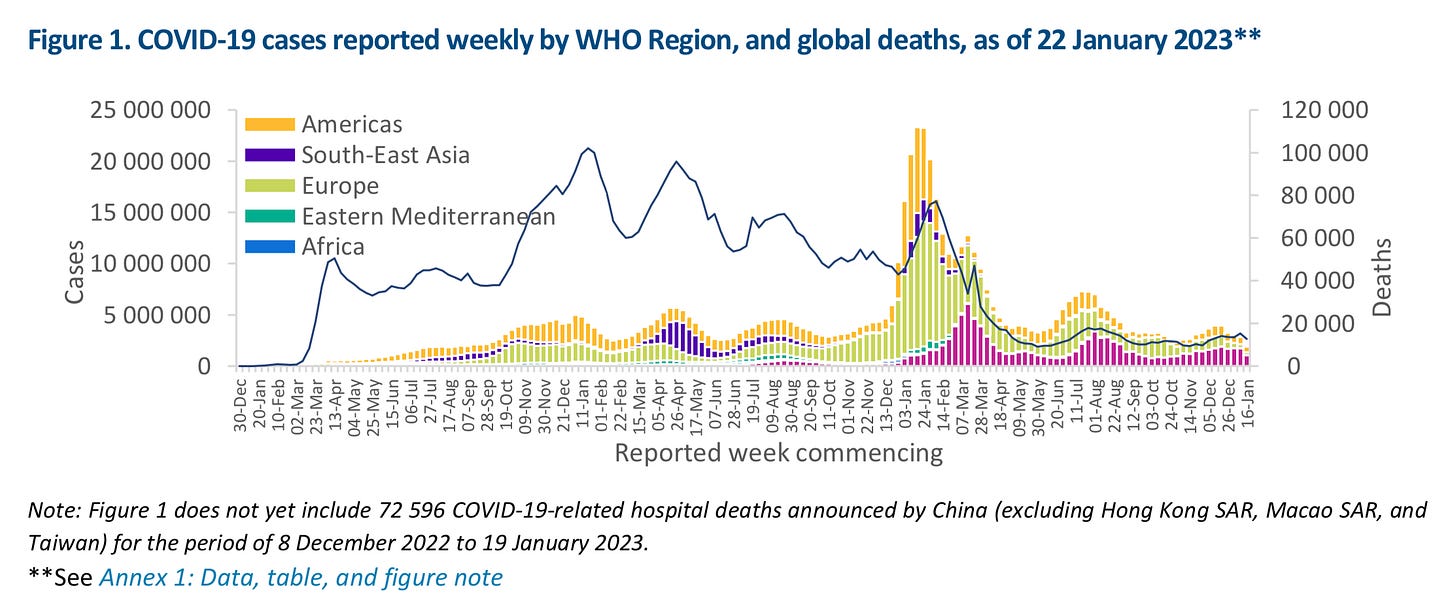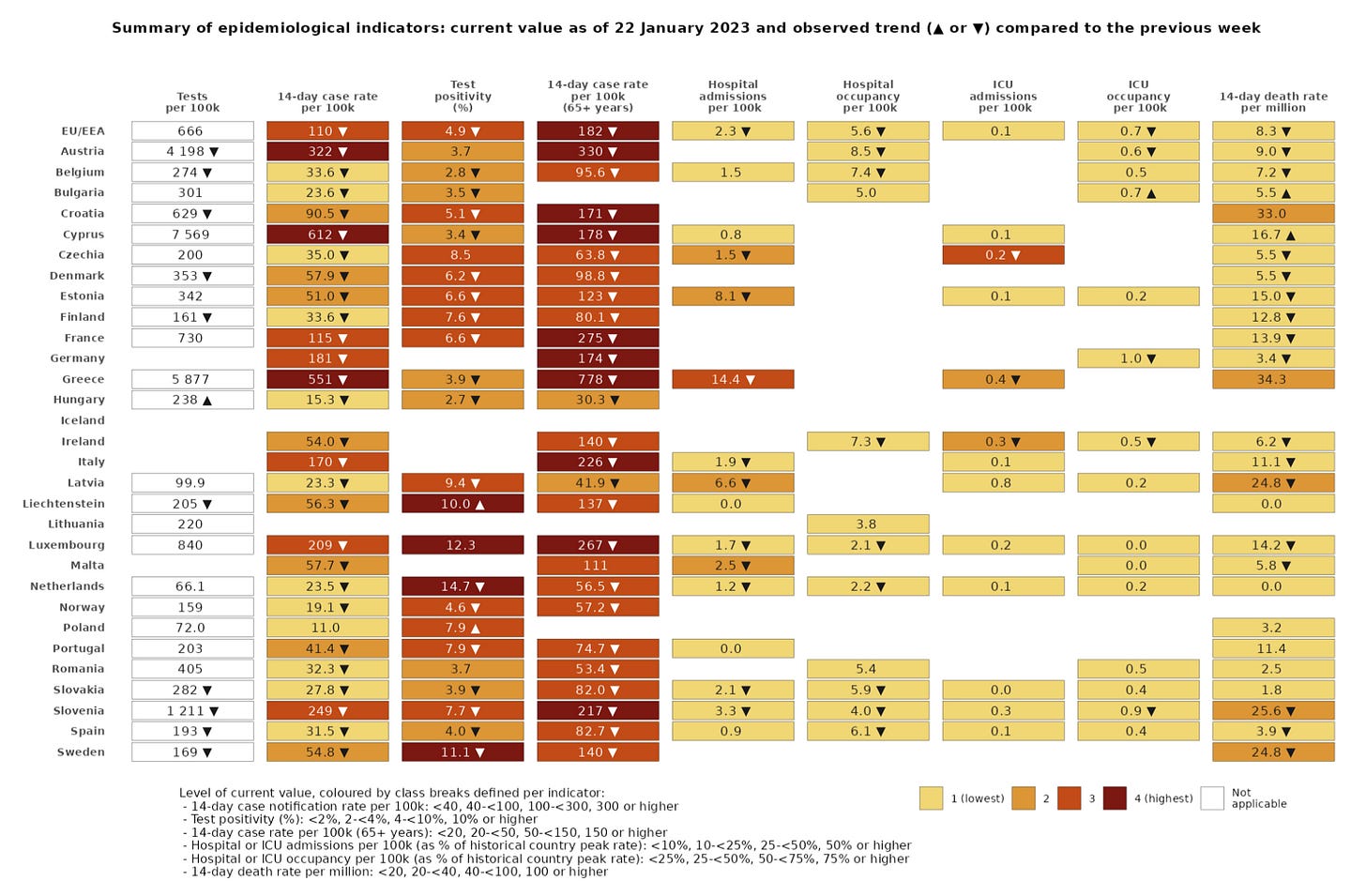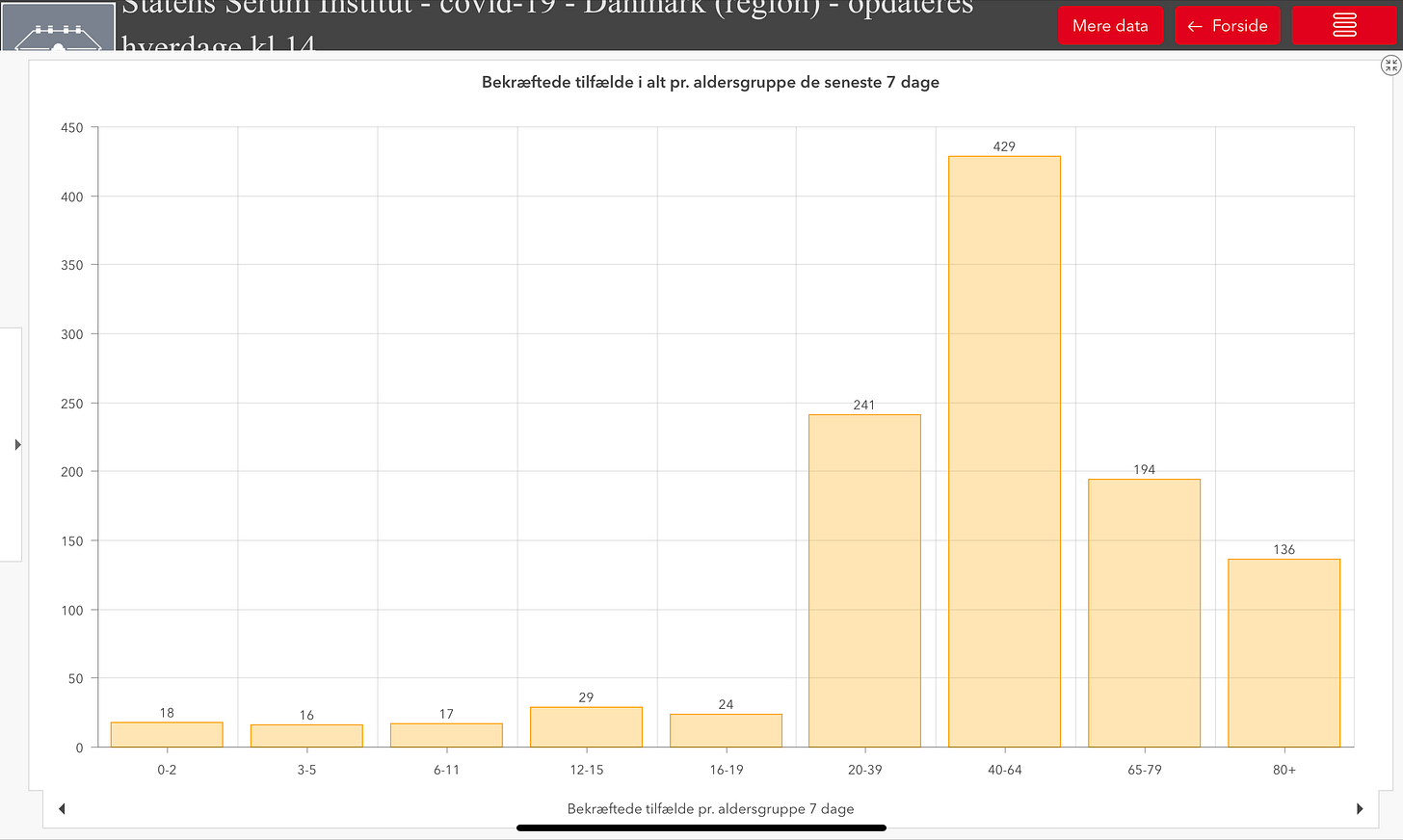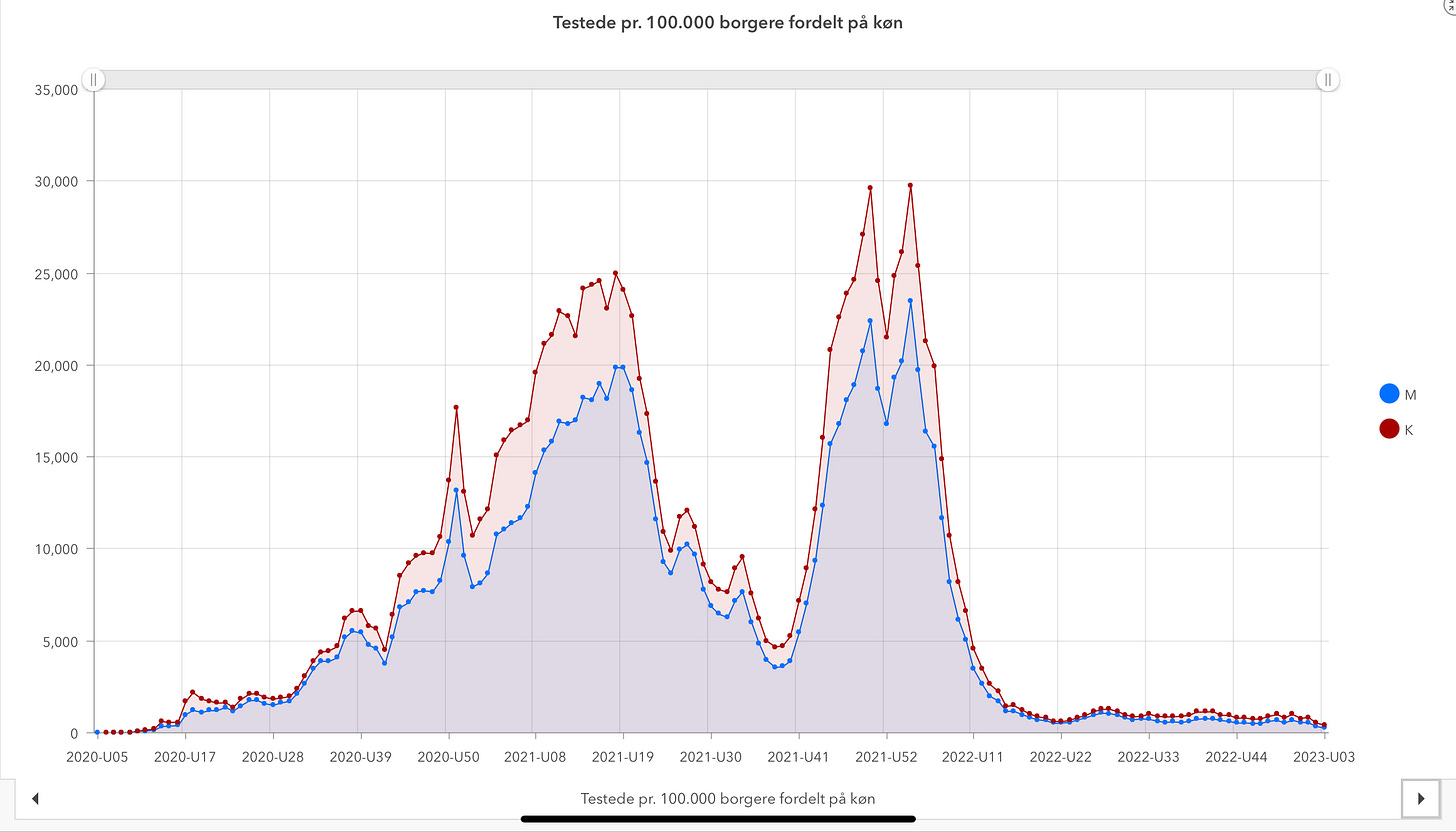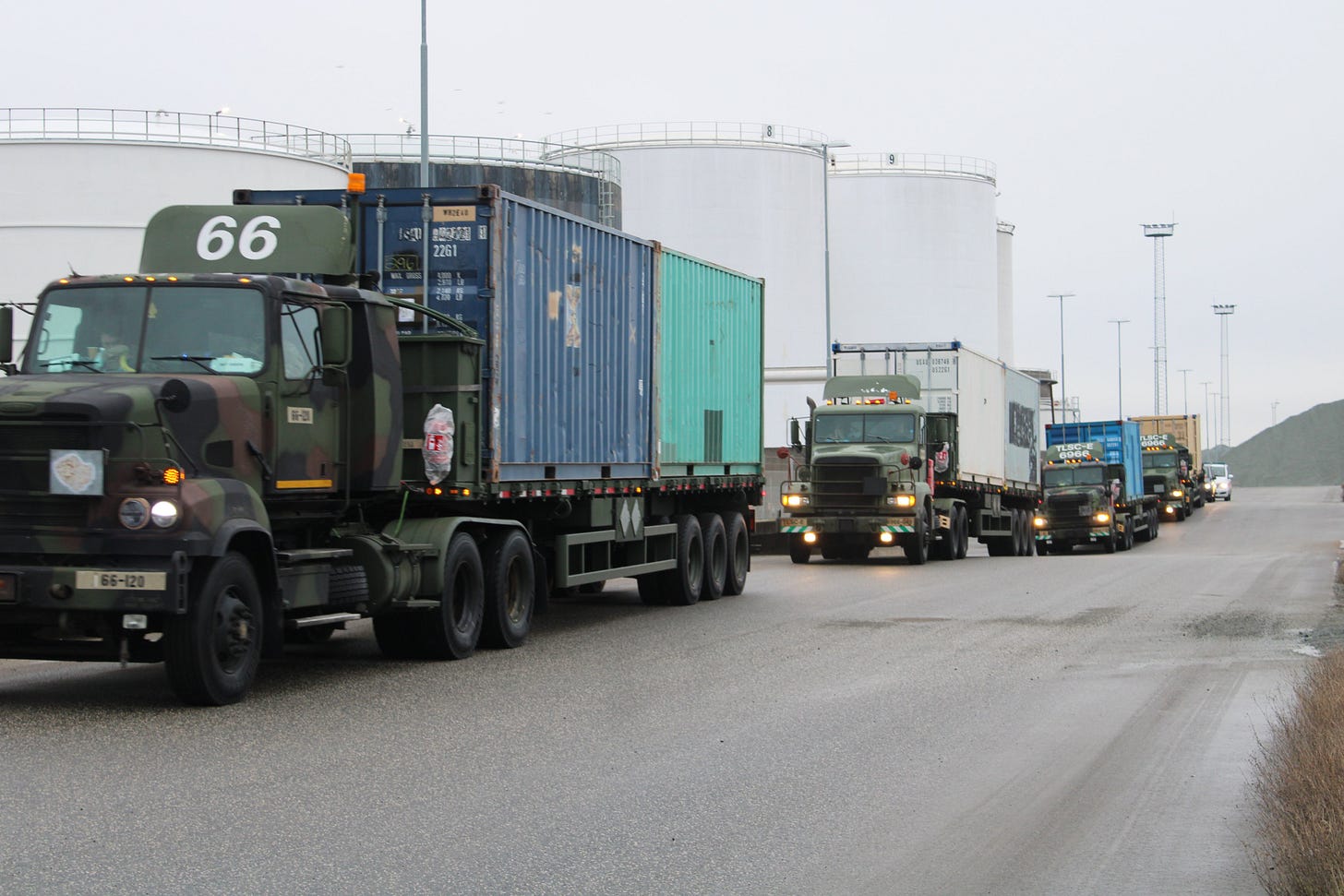Monday Morning News & Notes
Global COVID deaths continue to rise. Europe’s improved pandemic picture.
🦠Pandemic🦠
🌎🦠
Infection numbers down, COVID deaths up. The number of coronavirus cases around the world in the latest global update from the World Health Organization dropped by 25%, with over 11 million infections in the last 28 days. But with over 55,000 more lives lost over the same span, global deaths have risen by 13%. The WHO cautions the death toll does not include the 72,596 virus-related deaths reported by China from December 8 to January 19. The global health agency says it is awaiting “more detailed data” from China.
“Weekly and monthly trends need to be interpreted carefully considering the reduction in testing and delays in reporting in many countries during the recent holidays. Therefore, data presented in this report, especially for the most recent weeks, are incomplete, and any decreasing trends may change as updated information is incorporated.”
Across the six WHO healthy regions, the increase in pandemic deaths seems to be driven by the Eastern Mediterranean (+24%), as the only region to see fatalities rise. Of the other five, Africa saw the sharpest drop in deaths (-65%), followed by Europe (-42%), and the Western Pacific (-16%).
It was a similar story for the more unreliable infection statistics, with the Eastern Mediterranean seeing case numbers surge (+54%), again the only region to see an increase. While Africa saw the steepest decline (-41%), followed by the Western Pacific (-39%), and Europe (-33%).
Looking at individual countries, Japan remains a concern, having the most new infections (672,526/-34%) and second highest number of deaths (2,779/-2%) of any nation on earth. The United States also continues to be a disaster, again recording the highest loss of life of any country with 3,922 more American lives snuffed out (-8%) while seeing the second highest number of new infections with 323,721 (-25%).
Pandemic deaths have also risen dramatically in Brazil, with 952 fatalities (+108%) and in Spain, with 424 lives lost (+21%).
The WHO reports the BA.5 variant and its sub-variants continue to be dominant around the world, albeit with data on a three-week delay. The agency says it is continuing to keep a very close eye on the BF.7, BQ.1, BA.2.75, and XBB strains.
On the spread of the concerning XBB.1.5 variant, the WHO says it has now been confirmed in 54 countries around the world. Of those, it has the highest infection spread in the United States (75%). Other countries reporting XBB.1.5 include the United Kingdom (9.9%), Canada (3.0%), Denmark (2.0%), Germany (1.5%), Austria (1.3%), and Ireland (1.3%). The global health agency says the variant has the highest immune escape of any variant seen yet, but there is no sign yet that it results in more severe infections. Although the WHO cautions “the number of cases associated with XBB.1.5 is still low, so it is difficult to assess severity.”
🇪🇺🦠
2023 is starting off with a much more optimistic pandemic picture across the European Union. In its latest weekly assessment, the European Centre for Disease Prevention and Control says numbers across the board continue to plummet.
Of the 28 European countries reporting infection data, the ECDC says not one recorded seeing any increasing numbers. Of the 21 reporting hospital data, just one country (Bulgaria) registered increases in either hospitalizations or intensive care admissions. And only two countries, Bulgaria and Cyprus, of the 26 reporting pandemic death numbers saw increasing fatalities.
But, while there is a lot of good news on the COVID front in Europe, pandemic deaths continue to take a hard toll among vulnerable seniors. In the last four weeks, 27% of pandemic deaths have been elderly people between 65 and 79 years old. While 63% were among high-risk seniors over the age of 80.
The agency says that vaccination uptake for a second booster dose continues to be lackluster across Europe. Just 35% of at risk seniors over the age of 65 in Europe have a 4th dose. Across the total population, uptake was just 13.9%. In both cases coverage is well below the number of people who had a first booster shot.
The BQ.1 variant is dominant in Europe (56.7%) according to the just nine countries that are testing and sequencing in numbers high enough to derive any meaningful data. It is followed by the formerly dominate BA.5 strain (17.8%), and the growing new XBB.1.5 variant (2.7%).
🇩🇰
The numbers are dropping, but overall infection trends continue to hold firm. Over the last seven days in Denmark, coronavirus cases remained highest in the 20 to 64 year-old group. We know from previous breakdowns from the Statens Serum Institute that it is really the 20 to 49 year old age groups, the age groups just outside the booster dose target group of those over the age of 50.
-
65% of all infection-related hospitalizations over the last week have been seniors over the age of 65. If you include those over 40, the percentage jumps to 88%.
-
I like to throw this graph in once in a while as a reminder of how far the Danish testing program has fallen. At its height almost 800,000 tests (PCR and rapid) were being administered each day. Now, it hovers around 3,000 daily PCR tests.
The WHO has repeatedly warned that less testing and sequencing essentially leaves us blind in the pandemic, unable to see infection trends or track emerging variants of concern.
🇸🇪
In an extremely brusk weekly update on the respiratory virus situation in Sweden, the country’s public health agency said confirmed cases of COVID, influenza, and RS virus continue to fall from peaks set last month. The falling numbers include cases among vulnerable seniors in care and those receiving care at home. It says intensive care capacity is also easing and deaths from both coronavirus and influenza are on the decline. In all cases it does not provide a single number or statistic, although the update does provide this reassuring line.
“The number of deaths from COVID or influenza continues to be reported.”
That said, the agency, again providing no details, says excess mortality rates were recorded in the last two weeks of December and the first week of January. It attributes this to the sheer spread of all respiratory infections, which were dominated by coronavirus, influenza, and RS virus.
State Epidemiologist Anders Lindblom:
“It is still important that those who are sick with respiratory infection symptoms stay at home and avoid close contact with others in order to reduce the ongoing spread of infection.”
The Swedish Public Health Agency also continues to urge people to get vaccinated against COVID and influenza.
-
Sweden has extended travel restrictions on all travelers from China for another 20 days. Everyone arriving in Sweden from China must continue to have a recent negative COVID test in order to enter the country. The restriction is now set to expire on February 18, unless it is extended again.
“The test requirement applies to adults and children over the age of 12 who are third-country nationals. There are certain exceptions to the test requirement that, for example, do not apply to people who have a residence permit in Sweden, who are permanently resident in the EU and EEA or who have urgent family reasons.”
Swedish citizens returning from China are also exempt.
🇫🇮
Sunday marked the third anniversary of Finland’s first confirmed coronavirus infection, a Chinese tourist, and while the pandemic has had plenty of awful repercussions, Yle is reporting there are also silver linings.
The Finnish media outlet says people appreciate nature and their free time a lot more. There is a lot more awareness about hygiene, especially in major retail chains. People also have much more awareness about staying home when they are sick, which has a positive impact on preventing infection spread. It says Finnish banks are reporting more uptake on things like online banking, mobile services, and a much faster transition away from using cash.
Finnish Institute for Health Research Professor Heikki Hiilamo says people are also much more appreciative of their quality of life. This includes an increase in working from home that he doesn’t see reverting back to pre-pandemic practices.
“Families spent more time together. This may explain the fact that the birth rate rose temporarily in the first years of the pandemic.”
He says Finns are also more appreciative of nature, noting visitor numbers at national parks shot up during the pandemic and have remained high.
“We realised that our wellbeing does not necessarily require the same level of consumption as before. The pandemic slowed our pace of life and gave us an opportunity to reflect on our own lives, our relationships with other people, and nature.”
-
Finns are traveling again, and in a big way. Finland recorded a record year for tourism in 2019, just before the pandemic. Statistics Finland says once COVID arrived tourism numbers fell off a cliff, both for visitors coming to Finland and Finns traveling out of the country.
The statistical agency says during the first two years of the pandemic staycations soared. People in Finland flocked to cabins and other rural destinations while largely avoiding big cities.
But, in 2021, international tourism began to pick up, according to the agency. By the spring of 2022, while numbers were improving they were still about half of pre-pandemic levels. By the summer of last year, tourism numbers continued to close the gap coming closer to equaling 2019’s record numbers.
Once pandemic travel restrictions were fully lifted, Finns flocked to neighbouring countries like Estonia and Sweden. Top fun in the sun travel spots were Spain and Greece.
🇫🇷/ 🇨🇳
Over the weekend, France also extended travel restrictions on all travelers arriving from China. The requirement for a mandatory recent negative COVID test for all Chinese travelers was due to expire January 31 (today) it has now been extended until February 15. The French government enacted the test mandate on December 30, due to China’s exploding pandemic situation.
🇪🇺💉
According to a report from Reuters, the European Union is in discussions with Pfizer/BioNTech to reduce the number of COVID vaccine doses it is contractually obligated to buy this year in return for paying a higher price. European authorities are apparently also trying to extend the delivery timeline for the remaining doses into 2024. The news agency is citing sources with knowledge of the talks in its report.
At the moment, there is a worldwide glut of vaccine doses, but in Europe there is a particularly large excess. This is due to the EU securing huge numbers of updated vaccine doses targeting specific variants and lackluster uptake of a 2nd booster dose across Europe.
In the contract the EU signed in May of 2021, the per dose price was €19.50 for each dose it was contractually obligated to buy. This could put this year’s total vaccine expenditure at possibly as high as €9 billion.
In the United States, Pfizer is hoping to charge around $110 per dose by this fall.
🇺🇦/ 🇷🇺 War
🇸🇪 🇩🇰 🇫🇮 🇳🇴/ 🇹🇷
An already fraught situation between Turkey and Sweden has gone from a slow burn to a major fire due to a right wing extremist burning the Quran. And, the President of Turkey, Recep Tayyip Erdoğan, is more than happy to fan the flames for political gain as he fights a national election battle. But, Russia may also be sneakily feeding the fire as well.
Over the weekend, the Foreign Affairs Ministries of Denmark, Sweden, Finland, and Norway, all warned their citizens in Turkey to be very careful and avoid large gatherings as protests in Turkey grow.
Swedish media are also reporting that the person who paid for the demonstration permit in Stockholm where the Quran was burned is a former contributor to Russia Today, a Kremlin backed propaganda channel.
In the days since, Turkey has canceled trilateral talks with Sweden and Finland over their NATO applications. Erdogan has accused Sweden and Denmark of endorsing hate crimes for the burning. The extremist who did it holds citizenship in both countries, and followed up his stunt in Stockholm by burning another Quran in Copenhagen. And the Turkish President is talking tough about outright vetoing Sweden’s NATO application, although he said on Sunday he wasn’t opposed to letting Finland in.
As well, a Turkish hacker group has taken credit for cyber attacks on Denmark’s National bank, saying “after you burned the Quran, we will burn your servers.” The attack briefly shut down the bank’s website. And whether it is linked or not, on Sunday, Denmark’s Ministry of Defense reported it had suffered a DDoS attack that briefly knocked its website offline on Sunday afternoon.
🇸🇪 🇫🇮/ 🇹🇷
Calling it a “difficult situation” NATO’s Secretary General, Jens Stoltenberg, says he still remains confident that both Sweden and Finland will join NATO, saying “the question is not if, but when.” Stoltenberg notes that this is already the fastest NATO application process, for both Sweden and Finland, than any other country that has joined the alliance. In the handful of months since submitting their applications, just Hungary and Turkey have yet to hold ratification votes after lightning fast approvals from the other 28 NATO member states. He says usually the process takes years.
Finland and Sweden need a yes from all 30 member nations to join NATO.
🇵🇱/ 🇺🇦
Poland continues to dig in and do everything possible and then some to support its Ukrainian neighbours. The country has taken in tens of thousands of Ukrainian refugees, kept up a steady flow of weapons and supplies into Ukraine, and pressured Germany to free up Leopard tanks for the Ukrainian army. Now the Wall Street Journal is reporting that Poland has launched a massive operation to repair damaged Ukrainian military equipment. A factory complex staffed by hundreds of technicians has become center stage in the operation to restore damaged artillery and heavy armour in order to get them back in the fight.
🇩🇰 🇺🇸
According to the Danish Armed Forces, the last convoy of US military equipment was loaded up in Aarhus harbour and is now on its way to the Baltic states. The shipment of weapons, ammunition, heavy armour, and other military supplies arrived by cargo ship in Aarhus a few weeks ago. With the last of it now headed to shore up NATO’s Easter flank, the areas of the port in Aarhus that were restricted should be opening up soon, if they haven’t already.
🇧🇪
Belgium will kick in another €92 million in military aid for Ukraine. In its largest weapons package yet, Belgium will hand the Ukrainian military air defense missiles, anti-tank weapons, ammunition, grenades, and more, according to Defense Minister Ludivine Dedonder.
🇩🇪/ 🇷🇺
German Chancellor Olaf Scholz has told a German newspaper, Tagesspiegel, that he is ready to have a conversation with Russian President Vladimir Putin again. The two leaders haven’t spoken since December 2. Scholz says it is important to maintain a dialog with the Russian President.
“I also want to talk to Putin again, because it is necessary to talk together.”
Germany has taken a lot of criticism for its often contradictory stance on supporting Ukraine against the Russian invasion. Recently, after months of dithering, it finally agreed to send 14 Leopard tanks to Ukraine. Germany has hundreds of the tanks.
🇬🇧/ 🇺🇦
Pictures have emerged of Ukrainian tank troops arriving in the United Kingdom to begin training on the British Challenger 2 tanks. The UK will donate 14 of them to Ukraine.
IOC/ 🇷🇺 🇧🇾
The International Olympic Committee is opening the door to allowing athletes from Russia and Belarus to compete in the 2024 games, which will be hosted in Paris. The IOC says if they do compete they will do so as ‘neutral athletes’ with no country affiliation worn or anthem played. Athletes from both countries had been excluded from the Games since Russia’s invasion of Ukraine. The news has been greeted with outrage by Ukraine and other countries who are urging the IOC to hold fast in excluding the two countries from international competition.
Among those expressing their displeasure is Estonian Prime Minister Kaja Kallas.






